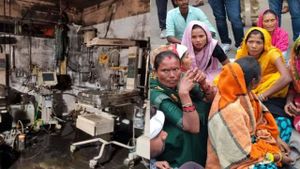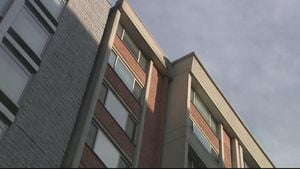Delhi has found itself at the center of a severe air pollution crisis, with air quality levels hitting record lows and forcing residents to reconsider their living situations. The city's suffocative smog, compounded by years of industrial emissions, vehicular pollution, and seasonal crop burning, has plunged the national capital and its neighboring regions, collectively known as the National Capital Region (NCR), deep under hazardous air quality.
Just last week, the Air Quality Index (AQI) soared to unprecedented heights, reaching as high as 490 out of 500—an alarming figure deemed hazardous by global standards. This shocking reality has led many residents to grapple not only with health issues like respiratory problems and chronic conditions but also with the looming question of whether to stay or leave.
Shivani Arora, who works as a marketing professional residing in South Delhi, shared her plight: "Every winter, I have to invest in air purifiers and medication for my kids. It feels like we’re fighting a losing battle. My husband and I are now considering moving to Bengaluru or Hyderabad for the sake of our children’s health." This sentiment is echoed throughout the city, where families are increasingly contemplating relocations to less polluted areas.
Interestingly, some families are seeking temporary reprieves from the toxic air, opting for short-term stays at resorts and clubs located in cities like Hyderabad and Chennai. Vikram Mehra, who works in IT, mentioned, "The pollution is unbearable, especially for older people. My parents are staying with me in Hyderabad for the winter months. It’s definitely been beneficial for their health and overall well-being." This trend of temporary escapes has surged with the rise of flexible work-from-home policies, allowing professionals to dodge Delhi’s notorious winter smog.
Not just seeking cleaner air, residents are being nudged toward greener pastures by the thriving real estate market in these cleaner cities. Hyderabad, for example, has emerged as an attractive relocation spot, boasting sturdy infrastructure and lower property prices compared to Delhi's inflated real estate market. Suman Joshi, a retired government employee who moved to Hyderabad, noted, "We sold our flat in Delhi and moved here. It’s refreshing, and we found spacious accommodations within our budget." For families considering relocation, the financial incentives add another layer to their decision-making process.
Despite the exodus of some residents, not everyone is ready to turn their back on Delhi. Many who own property or have deep roots—be it through family ties or established careers—feel tethered to the city. "Many of us are tied to the city because of work or family. But if I get a similar job elsewhere and sell my house for a good price, I will leave because this is not the environment I would want to raise my children in," explained Sandeep Gupta, a school teacher.
The compelling choices faced by residents speak not just to their personal health concerns but also to broader societal issues. Hospitals across the capital have reported notable upticks in pollution-related illnesses, leaving healthcare providers scrambling to address the fallout of the deteriorated air quality. Dr. Priya Malhotra, a pulmonologist, remarked, "We are observing more cases of respiratory issues, even among young children. Patients are asking about air quality elsewhere and contemplating relocating for health reasons."
Indeed, this health crisis has unveiled the inadequacies of policy responses concerning Delhi's air pollution problem. The challenge is multifaceted and exacerbated by the city's geographical, industrial, and infrastructural limitations. The NCR, comprising various states, complicates cohesive governance and effective pollution management, resulting in fragmented efforts and frustration among residents. Richard Pereira, a real estate agent, encapsulated the growing anxiety: "The discontent is rising. With Delhi being the hub for industries and opportunities, maintaining its livability is extremely important. Unless sustained efforts are made to tackle pollution, more residents might choose to leave, forever reshaping migration patterns across India."
The crisis isn’t merely about individuals or families anymore; it’s become emblematic of Delhi's sustainability as a livable city. The recent ban on construction activities—an action taken to mitigate the city's pollution—has deeply affected blue-collar workers, who rely on these jobs to survive. Many are living at construction sites where work has stalled, covered by makeshift structures and braving smoke-filled air.
Meanwhile, the educational sector is also feeling the pressure of pollution. Schools across Delhi-NCR have faced repeated temporary closures due to the degrading air quality, with the District Magistrate of Noida enforcing online classes until at least November 25. The Supreme Court's decision on the Graded Response Action Plan (GRAP) has become pivotal, with judges determining whether to ease restrictions as air quality fluctuates. The situation remains volatile, as recent reports from Anand Vihar recorded alarming AQI levels between 334 and 340.
Evidently, Delhi's struggle with hazardous air pollution has morphed from just environmental concern to practical survival, affecting economic choices, healthcare outcomes, and social cohesion. While debates over government accountability and remedial legislation continue, the very essence of living and thriving within the capital is being challenged.
The struggle with air quality is a continuing saga for residents of Delhi and the NCR, prompting urgent discussions and actions. Moving forward, the onus is on both individuals and the authorities to address the pressing health crisis and restore the region’s air quality, ensuring it's conducive for future generations. Without serious commitment and action, Delhi's toxic air may lead to irreversible changes—many may just opt to leave altogether, searching for places where they can breathe easy.



